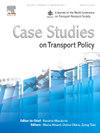Regional impact assessment of highways and policy Interventions: Lessons from Haryana, India
IF 2.4
Q3 TRANSPORTATION
引用次数: 0
Abstract
The construction of highway infrastructure is essential for fostering economic growth, promoting connectivity, and influencing regional planning. This study assesses the consequences of roads (highways) in Haryana State, India, concentrating on highway lengths, highway density, modal distribution, economic performance, road safety, and environmental impacts. The research adheres to the Cross-Industry Standard Process for Data Mining (CRISP-DM) framework to ensure a methodical approach for the analysis. A quantitative analysis utilising correlation analysis and k-means clustering was performed to evaluate the relationship between highway growth and identified parameters. The research employs district-level data from 2003 to 2023, obtained from MoRTH (2023), the Statistical Abstract of Haryana (2024), and the National Crime Records Bureau (2024). The findings demonstrate a significant association between highway length and GDP, highlighting the importance of highways in economic advancement. The k-means clustering method categorised districts into five unique clusters, revealing regional inequalities in infrastructure development, economic progress, and accident frequencies. The study highlights an increase in road accidents in high-traffic districts and a rise in PM2.5 and CO2 emissions, emphasizing sustainability challenges. The study offers a framework for assessing highway impacts and suggests policy solutions with immediate, short-term, and long-term applications to tackle regional inequities, road safety issues, and environmental sustainability. The investigation formulates a framework for the examination of highway impacts and suggests policy interventions to policymakers, urban planners, transport authorities, and regional development agencies that can be implemented in the short, medium, and long term to mitigate regional disparities, environmental sustainability, and road safety concerns.
高速公路的区域影响评估和政策干预:来自印度哈里亚纳邦的经验教训
公路基础设施建设对促进经济增长、促进互联互通、影响区域规划至关重要。本研究评估了印度哈里亚纳邦道路(高速公路)的后果,重点关注公路长度、公路密度、模式分布、经济绩效、道路安全和环境影响。该研究遵循数据挖掘跨行业标准流程(CRISP-DM)框架,以确保分析方法的系统性。利用相关分析和k-means聚类进行定量分析,以评估公路增长与识别参数之间的关系。该研究使用了2003年至2023年的地区级数据,这些数据分别来自北方统计局(2023)、哈里亚纳邦统计摘要(2024)和国家犯罪记录局(2024)。研究结果表明,高速公路长度与GDP之间存在显著关联,凸显了高速公路在经济发展中的重要性。k-means聚类方法将地区分为五个独特的聚类,揭示了基础设施发展、经济进步和事故频率方面的地区不平等。该研究强调了交通繁忙地区道路交通事故的增加,以及PM2.5和二氧化碳排放量的增加,强调了可持续发展的挑战。该研究为评估公路影响提供了一个框架,并提出了近期、短期和长期适用的政策解决方案,以解决区域不平等、道路安全问题和环境可持续性问题。该调查为审查公路影响制定了一个框架,并向政策制定者、城市规划者、交通当局和区域发展机构提出了可以在短期、中期和长期实施的政策干预措施,以减轻地区差异、环境可持续性和道路安全问题。
本文章由计算机程序翻译,如有差异,请以英文原文为准。
求助全文
约1分钟内获得全文
求助全文

 求助内容:
求助内容: 应助结果提醒方式:
应助结果提醒方式:


